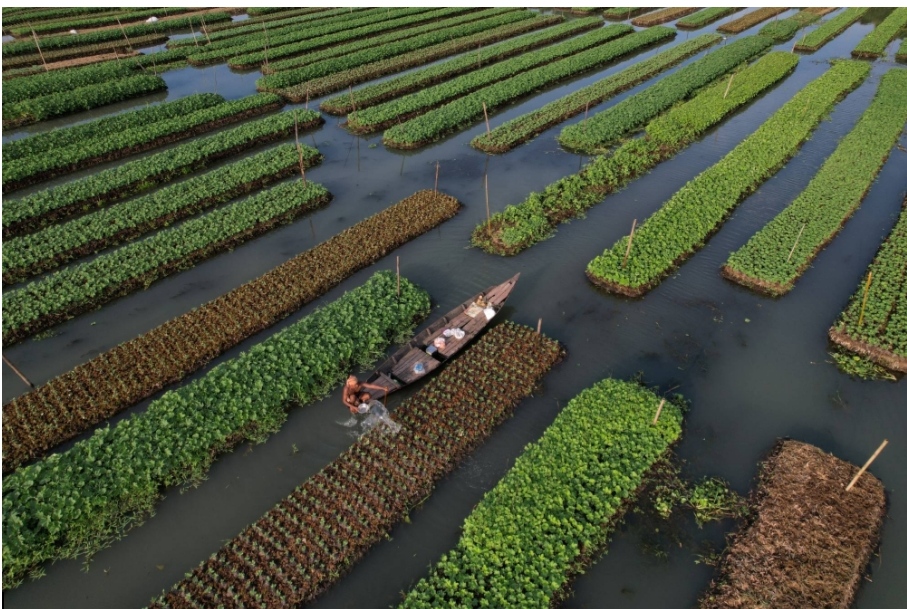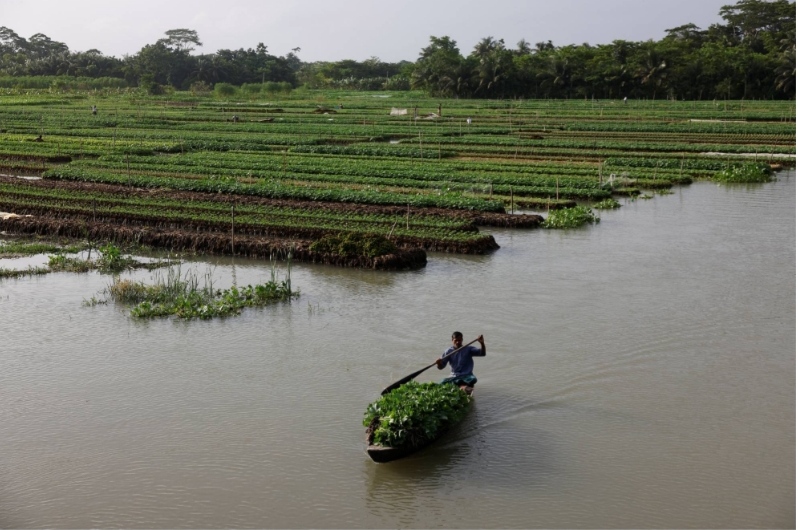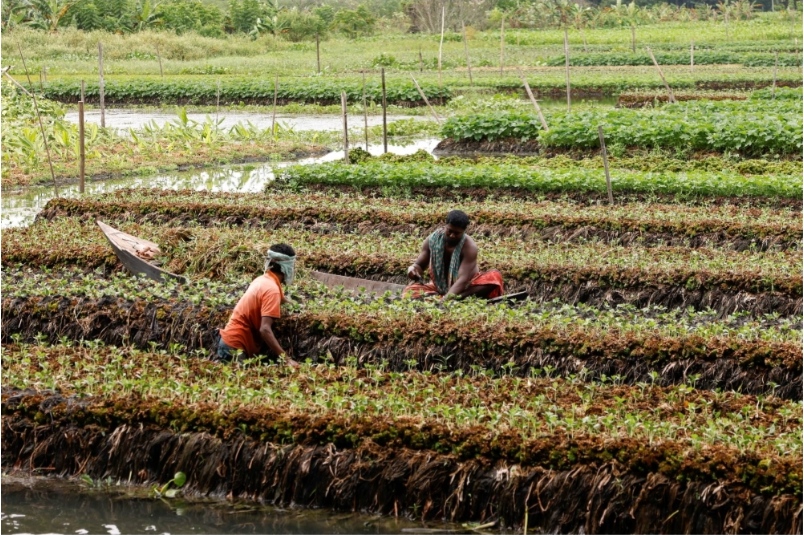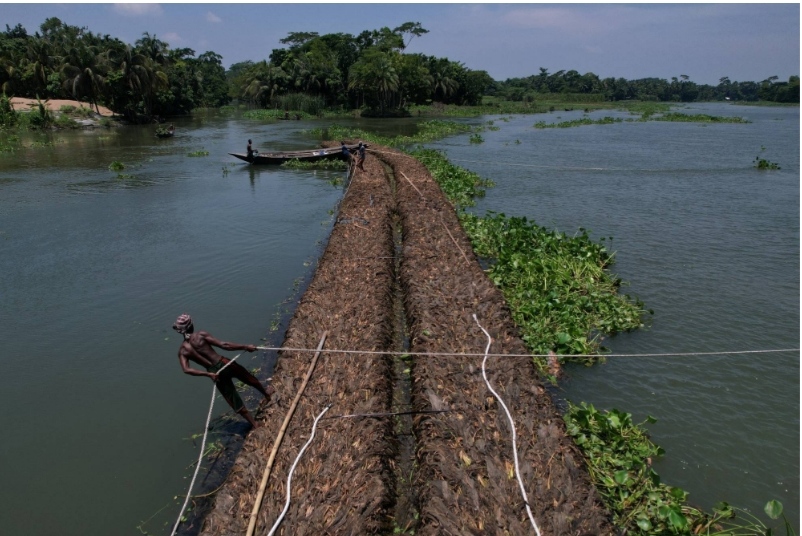How floating farms are helping Bangladesh adapt to climate change?

A farmer irrigates his floating bed, at his farm in Pirojpur district, Bangladesh, in August 2022.
BY PETER YEUNG
To reach his farm, Mohammad Mohasin has an unusual commute. The 40-year-old either rows in a wooden canoe or swims to the field of crops — which is floating in a body of water in Barisal, a southern region of Bangladesh.
Tomatoes, pumpkins, potatoes, beans, eggplants and cucumbers are among the produce that he cultivates in curiously green, buoyant rows.
“If I grew these on a normal field, the floods would destroy them,” says Mohasin, a third-generation farmer of the floating gardens, known locally as dhap. “But when the water levels rise here, so does my garden.”
A traditional form of hydroponics that dates back at least 400 years, gardens like these are being recognized as a climate-resilient, nature-based solution that can keep the country’s increasingly flood-hit farmers afloat.
Low-lying Bangladesh is among the nations most vulnerable to impacts of climate change. Much of its land is flooded after severe monsoons, and by 2050 rising sea levels and coastal erosion could displace 20 million people, the World Bank has estimated, while submerging a substantial amount of land and wiping out a large share of food production.

A man carries gourd seedlings to be sold to middlemen, at his floating farm in Pirojpur district, Bangladesh, in August 2022.
As climate change intensifies monsoons, accelerates Himalayan snow melt and makes cyclones more frequent, agriculture systems such as rice paddies are no longer as reliable because they are easily damaged by weather and will be prone to saltwater intrusion. Since about half of Bangladesh’s workforce works in agriculture, adaptation strategies are desperately needed.
Barisal’s rectangular floating rafts, which rise and fall with swells, are mostly made of a tightly-knit weed known as water hyacinth, sometimes bolstered with bamboo poles. In a layer of manure on top of them, farmers plant fruits, vegetables and spices. Similar forms of soil-free cultivation exist in other parts of Asia, such as Dal Lake in Kashmir and Inle Lake in Myanmar.
The low cost of establishing the gardens makes them a viable option for Bangladesh’s rural population. And they offer a range of other benefits: The waters around them can be used to farm fish or shelter livestock during heavy monsoons. Farmers say that even when cyclones cause unavoidable damage, the farms can be rebuilt quickly.
“When everything is washed away, it doesn’t take long to recover,” says Mohammad Shamsul Haque, a 64-year-old farmer in Barisal who has been cultivating a floating garden for 40 years. “It’s easy to do for those who know how to do it.”

A farmer places water weeds on top of seedlings’ roots, at his floating farm in Nazirpur, Pirojpur district, Bangladesh, in August 2022.
Lessons from Bangladesh could have global value as the world shifts to a flood-prone future. According to the United Nations Food and Agricultural Organization (FAO), floods caused $21 billion of crop and livestock losses in low and lower-middle income countries between 2008 and 2018. Academic research published last year found that 1.8 billion people globally are directly exposed to flood risk.
“People in Bangladesh are fighting all types of disaster,” says Abdullah Al-Maruf, a professor of geography and environmental studies at the University of Rajshahi in the west of the country. “With sea level rise, the Bengal delta will be submerged. We need to disseminate the story of floating gardens, so others can take them up.”
In recognition of floating gardens’ potential, the FAO in 2015 designated 2,500 hectares of floating gardens in Bangladesh as one of the world’s 62 Globally Important Agricultural Heritage Systems, estimating that the country could cultivate up to 2 million hectares (about 7,700 square miles) this way.
Since then, the government of Bangladesh has attempted to widen the cultivation of floating gardens through a pilot project that began in 2017. To date, 25,000 farmers in 24 districts have received training, seeds, pesticides and logistical support. The Bangladesh Agricultural Research Institute has also conducted research to make cultivation more efficient, working with the country’s Department of Women Affairs to help marginalized women raise rice seedlings and cultivate vegetables. The target to increase vegetable and spice production by 10% has already been achieved.
“It’s clear floating agriculture is a success in Bangladesh,” says Bibekananda Hira, who works on the project to popularize floating-bed cultivation. “But there’s still work to do.”

A man holds a rope as people transport floating beds toward a farm through the Belua river in Pirojpur district, Bangladesh, in August 2022.
A 2020 study published in the Journal of Agriculture, Food and Environment found floating gardens represent “a sustainable and lucrative” income for rural households in flood-prone regions of Bangladesh. Yet the researchers found farmers often must take out high-interest loans to begin and that the gardens can be susceptible to pests.
“It’s a flourishing opportunity,” says Al-Maruf, who was one of the authors. “But we need more research. Green chilies might be good for economic reasons, but are they good for food security? Is (floating-farm agriculture) actually effective for addressing sea level rise?”
Previous NGO-led initiatives had mixed results. In 2005, the United Kingdom-based nonprofit Practical Action led a project to introduce floating gardens in northern Bangladesh, and CARE International and the International Union for Conservation of Nature ran a pilot in the northeast. In 2010, there was an effort to introduce the practice in a third area. But long-term uptake was limited.
“The focus was too much on humanitarianism,” says Haseeb Irfanullah, an independent environmental consultant and former program coordinator at the International Union for Conservation of Nature. “The government has had more success with a business-focused model, since there’s more of an incentive. But it must not leave marginal farmers behind.”
Back in Barisal, the age-old cultivation of floating gardens is still bearing fruit. Mohammad Mohasin, who is teaching his three children how to farm, says that the gardens bring in up to 70,000 taka ($658) a month during the peak harvest season.
“It’s more profitable than other farms,” says Mohasin, as he gathers half a dozen thigh-sized green squashes from his buoyant field. “And cultivating them comes very naturally to us here in Bangladesh. It’s genetic.”




